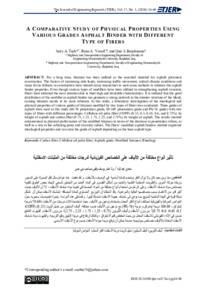Document
A comparative study of physical properties using various grades asphalt binder with different type of fibers.
Identifier
DOI:10.24200/tjer.vol17iss1pp34-40
Contributors
Yousif, Rana A, Author
Banyhussan, Qais S., Author
Other titles
دراسة مقارنة للخصائص الفيزيائية باستخدام درجات مختلفة من رابط الأسفلت وأنواع مختلفة من الألياف.
Country
Oman.
City
Muscat
Publisher
College of Engineering, Sultan Qaboos University.
Gregorian
2020
English abstract
For a long time, bitumen has been utilized as the essential material for asphalt pavement construction. The factors of increasing axle loads, increasing traffic movement, critical climate conditions and many forms failures in construction have steered many researchers to seek some methods to enhance the asphalt binder properties. Even though various types of modifiers have been utilized in strengthening asphalt concrete, fibers have attracted the most attention due to their high and desirable characteristics. It is realized that the good distribution of the modifier in asphalt binder can generate a strong network in the interior structure of the blend, causing bitumen mastic to be more coherent. In this study, a laboratory investigation of the rheological and physical properties of various grades of bitumen modified by two types of fibers was conducted. Three grades of asphalt were used in this study (60-70 penetration grade, 80-100 penetration grade and PG-76 grade) with two types of fibers with different percentages—cellulose oil palm fiber (COPF) (0.15, 0.3, 0.45, 0.6, and 0.75%) by weight of asphalt and carbon fiber (0.75, 1.25, 1.75, 2.25, and 2.75%) by weight of asphalt. The results showed enhancement in physical performance of the modified bitumen in terms of the decrease in penetration values, as well as a rise in the softening point and viscosity values. The fibers’ modified asphalt binders showed improved rheological properties and can raise the grade of asphalt depending on the base asphalt type.
ISSN
Online: 1726-6742
Print: 1726-6009
Arabic abstract
كان ولا يزال القار يستخدم كمادة أساسية في الرصف الأسفلتي. لقد دفعت عدة عوامل مثل حمولة المحور، وزيادة حركة المرور، والظروف المناخية القاسية، والعديد من أشكال القصور في البناء العديد من الباحثين إلى السعي لإيجاد طرق قوية لتحسين خصائص مادة التماسك. على الرغم من استخدام أنواع مختلفة من المواد المحسنة لتقوية مواد التماسك الأسفلتي، إلا أن الألياف جذبت أكبر قدر من الاهتمام بسبب خصائصها العالية والمرغوبة. لاحظنا أن التوزيع المتساوي للمادة المضافة في مادة التماسك الأسفلتي يمكن أن يولد شبكة قوية في البنية الداخلية للمزيج، مما يؤدي إلى عجينة أسفلتية أكثر تماسكًا. قمنا في هذه الدراسة بإجراء فحوصات مخبرية للخواص الحركية والفيزيائية لمختلف أنواع القار المعدل باستخدام نوعين من الألياف. استخدمنا ثلاث درجات من الأسفلت (60-70، 80-100، وPG-76) مع نوعين من الألياف بنسب مختلفة، ألياف السليلوز من نخيل الزيت (0.15، 0.3، 0.45، 0.6، و0.75٪ من وزن الأسفلت)، وألياف الكربون (0.75، 1.25، 1.75، 2.25، و2.75٪ من وزن الأسفلت). أظهرت النتائج تحسنًا في الأداء الفيزيائي للأسفلت المعدل من حيث انخفاض قيم الاختراق، وكذلك ارتفاع في درجة التليين وقيم اللزوجة. كما أظهرت خصائص حركية محسنة يمكن أن ترفع درجة الأسفلت حسب نوع الأسفلت الأساسي.
Category
Journal articles

